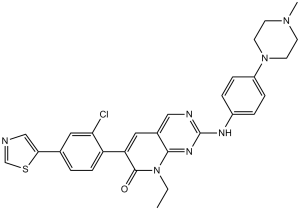FRAX597 (FRAX-597; FRAX 597) is a novel, potent and ATP-competitive inhibitor of group I PAKs (p21-activated Kinases) with potential anticancer activity. It inhibits PAK1, PAK2, and PAK3 with IC50s of 8 nM, 13 nM, and 19 nM, respectively. FRAX597 inhibits tumorigenesis of neurofibromatosis type 2 (NF2)-associated Schwannomas. FRAX597 inhibits the proliferation of NF2-deficient schwannoma cells in culture and displayed potent anti-tumor activity in vivo, impairing schwannoma development in an orthotopic model of NF2. These studies identify a novel class of orally available ATP-competitive Group I PAK inhibitors with significant potential for the treatment of NF2 and other cancers.
Physicochemical Properties
| Molecular Formula | C29H28CLN7OS | |
| Molecular Weight | 558.10 | |
| Exact Mass | 557.176 | |
| CAS # | 1286739-19-2 | |
| Related CAS # |
|
|
| PubChem CID | 70934541 | |
| Appearance | Light yellow to yellow solid powder | |
| LogP | 5.977 | |
| Hydrogen Bond Donor Count | 1 | |
| Hydrogen Bond Acceptor Count | 8 | |
| Rotatable Bond Count | 6 | |
| Heavy Atom Count | 39 | |
| Complexity | 878 | |
| Defined Atom Stereocenter Count | 0 | |
| InChi Key | DHUJCQOUWQMVCG-UHFFFAOYSA-N | |
| InChi Code | InChI=1S/C29H28ClN7OS/c1-3-37-27-20(14-24(28(37)38)23-9-4-19(15-25(23)30)26-17-31-18-39-26)16-32-29(34-27)33-21-5-7-22(8-6-21)36-12-10-35(2)11-13-36/h4-9,14-18H,3,10-13H2,1-2H3,(H,32,33,34) | |
| Chemical Name | 6-[2-chloro-4-(1,3-thiazol-5-yl)phenyl]-8-ethyl-2-[4-(4-methylpiperazin-1-yl)anilino]pyrido[2,3-d]pyrimidin-7-one | |
| Synonyms |
|
|
| HS Tariff Code | 2934.99.9001 | |
| Storage |
Powder-20°C 3 years 4°C 2 years In solvent -80°C 6 months -20°C 1 month |
|
| Shipping Condition | Room temperature (This product is stable at ambient temperature for a few days during ordinary shipping and time spent in Customs) |
Biological Activity
| ln Vitro | It is found that FRAX597 is a strong, ATP-competitive inhibitor of group I PAKs (PAK 1-3), with the following biochemical IC50 values: PAK2 IC50 = 13 nM, PAK3 IC50 = 19 nM, and PAK1 IC50 = 8nM. PAK4, a member of group II PAKs, has an IC50 of greater than 10 μM. FRAX597 exhibits a notable (>80% inhibition) inhibitory ability at 100 nM towards YES1 (87%), RET (82%), CSF1R (91%), TEK (87%), PAK1 (82%), and PAK2 (93%). Using the Kinase Glo Assay with 20 nM protein and 1 μM ATP, FRAX597 demonstrated an IC50 value of 48 nM against PAK1 wild type, whereas IC50 values against PAK1 mutants V342F and V342Y exceed 3 μM and 2 μM, respectively[1]. | ||
| ln Vivo | A comparison between the tumor growth rates of FRAX597-treated and control mice shows that the tumor growth rate in the animals in the two cohorts is much slower. The animals are slaughtered and the tumors are removed and weighed following a 14-day course of treatment. When compared to the control group, the FRAX597-treated cohort exhibits a considerably lower average tumor weight [1]. | ||
| Animal Protocol |
|
||
| References |
[1]. FRAX597, a small molecule inhibitor of the p21-activated kinases, inhibits tumorigenesis of neurofibromatosis type 2 (NF2)-associated Schwannomas. J Biol Chem. 2013 Oct 4;288(40):29105-14. |
Solubility Data
| Solubility (In Vitro) |
|
|||
| Solubility (In Vivo) |
Solubility in Formulation 1: 1.43 mg/mL (2.56 mM) in 10% DMSO + 40% PEG300 + 5% Tween80 + 45% Saline (add these co-solvents sequentially from left to right, and one by one), suspension solution; with sonication. For example, if 1 mL of working solution is to be prepared, you can add 100 μL of 14.3 mg/mL clear DMSO stock solution to 400 μL PEG300 and mix evenly; then add 50 μL Tween-80 to the above solution and mix evenly; then add 450 μL normal saline to adjust the volume to 1 mL. Preparation of saline: Dissolve 0.9 g of sodium chloride in 100 mL ddH₂ O to obtain a clear solution. Solubility in Formulation 2: 1.43 mg/mL (2.56 mM) in 10% DMSO + 90% (20% SBE-β-CD in Saline) (add these co-solvents sequentially from left to right, and one by one), suspension solution; with ultrasonication. For example, if 1 mL of working solution is to be prepared, you can add 100 μL of 14.3 mg/mL clear DMSO stock solution to 900 μL of 20% SBE-β-CD physiological saline solution and mix evenly. Preparation of 20% SBE-β-CD in Saline (4°C,1 week): Dissolve 2 g SBE-β-CD in 10 mL saline to obtain a clear solution. Solubility in Formulation 3: ≥ 1.43 mg/mL (2.56 mM) (saturation unknown) in 10% DMSO + 90% Corn Oil (add these co-solvents sequentially from left to right, and one by one), clear solution. For example, if 1 mL of working solution is to be prepared, you can add 100 μL of 14.3 mg/mL clear DMSO stock solution to 900 μL of corn oil and mix evenly. (Please use freshly prepared in vivo formulations for optimal results.) |
| Preparing Stock Solutions | 1 mg | 5 mg | 10 mg | |
| 1 mM | 1.7918 mL | 8.9590 mL | 17.9179 mL | |
| 5 mM | 0.3584 mL | 1.7918 mL | 3.5836 mL | |
| 10 mM | 0.1792 mL | 0.8959 mL | 1.7918 mL |
